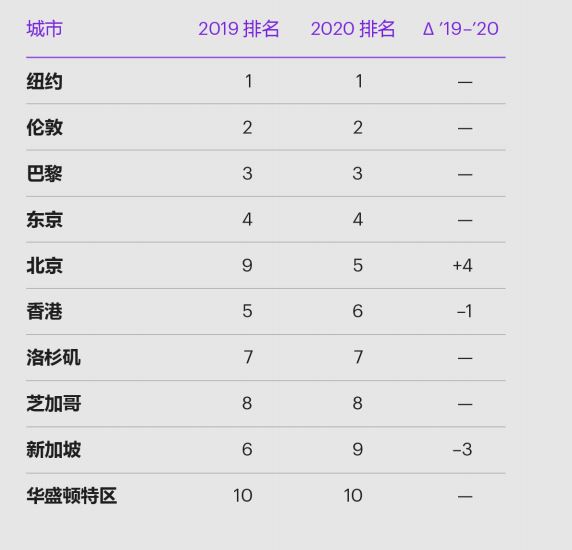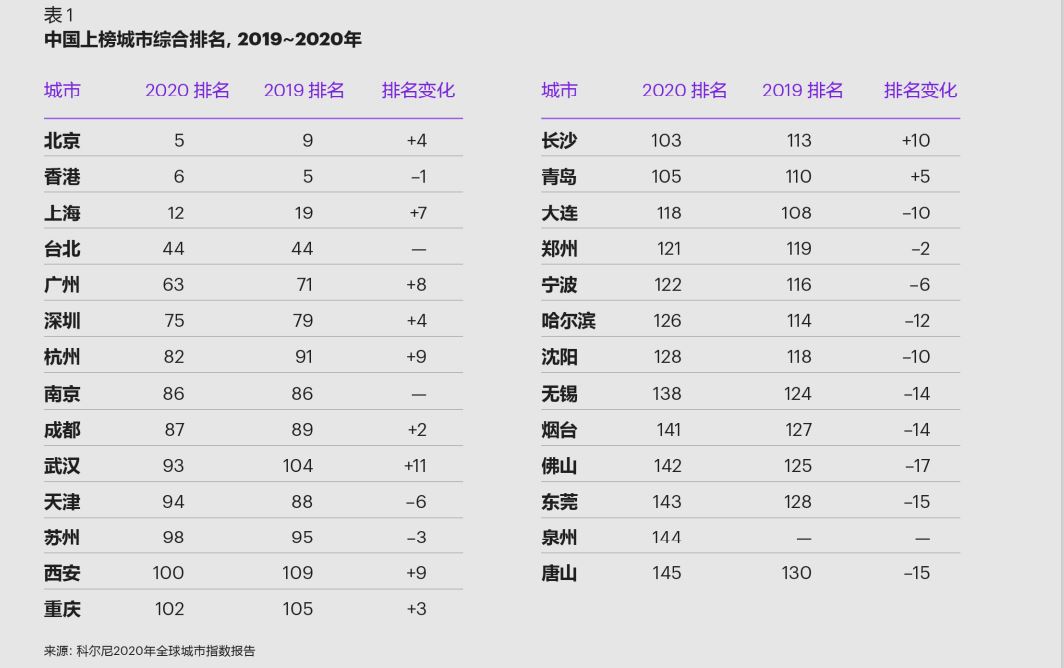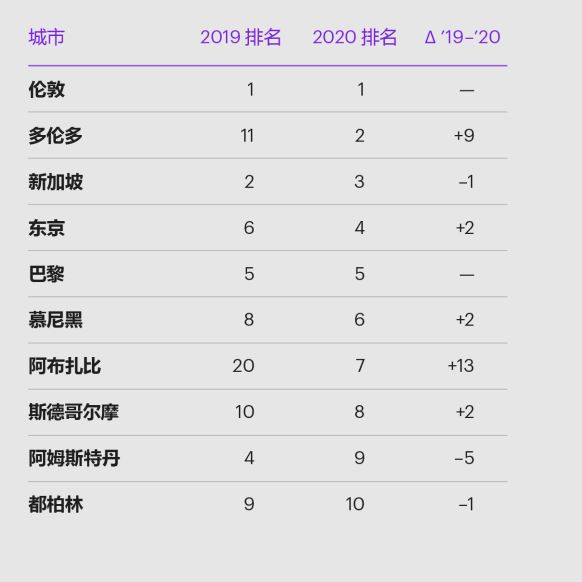On November 18th, A.T. Kearney (hereinafter referred to as "Kearney Company"), an international management consulting company, released the 2020 Global City Index Report, revealing the most competitive cities and the most promising cities in the world. This year is the fourth consecutive year that new york ranks first in global cities. Among China cities, Beijing has surpassed Hongkong and entered the fifth place in the world historically.
At the same time, Shanghai, Guangzhou, Shenzhen and other first-tier cities, as well as Nanjing, Hangzhou, Qingdao, Chengdu, Chongqing and other "new first-tier" cities have also significantly improved their rankings.
Kearney Company was founded in Chicago in 1926 and now has branches in more than 40 countries. Its "Global City Index" report was first published in 2008, and was jointly initiated by Kearney Company, top international scholars and think tanks. This year is the 12th year that Kearney has released this report.
The 2020 Global City Index Report includes Global City Comprehensive Ranking and Global City Potential Ranking. The number of emerging cities has been greatly increased in the selection process of the two lists this year, and the number of cities comprehensively evaluated has increased from 130 in 2019 to 151 in 2020.
Kearney’s Global City Comprehensive Ranking (GCI) ranks the status quo of cities based on 29 indicators in five dimensions: business activities, human capital, information exchange, cultural experience and political affairs. The Global Urban Potential Ranking (GCO) ranks the future potential of cities based on 13 key indicators in four dimensions (residents’ happiness, economic situation, innovation and governance).
At the same time, this year’s report optimization introduced some new indicators, including the measurement dimension of urban entrepreneurship and urban public health level.
Beijing entered the top five for the first time, and new york, London, Paris and Tokyo still led.
Top Ten in the Comprehensive Ranking of Global Cities in 2020
In this year’s Comprehensive Ranking of Global Cities, Beijing surpassed Hong Kong and historically entered the fifth place in the world. This is also the first time that the ranking of the top five cities has changed since the release of the first report in 2008. The report believes that the important reason for Beijing’s rising ranking is its outstanding performance in the field of entrepreneurial innovation, which is the joint effect of social stability, human capital investment and the improvement of innovation and entrepreneurship.
In addition to Beijing, among other first-tier cities in China, Shanghai jumped to the 12th place in the world, ranking 7 places higher. Shenzhen rose by 4 places; Guangzhou rose by 8 places, mainly in the dimensions of human capital and cultural experience.
In addition to the first-tier cities, the ranking of "new first-tier" cities in China has also increased significantly. After entering the top 100 for the first time in 2019, Hangzhou rose by 9 places in 2020, ranking 82nd. According to the report, the rapid rise of Hangzhou’s ranking is due to the continuous improvement of business activities and cultural experience, especially in the number of new unicorn enterprises.
Chengdu ranks 2 places higher, ranking 87th. According to the report, Chengdu is becoming a new fulcrum of talent gathering in China. In addition, the number of international leading professional service organizations in Chengdu is second only to that in Guangzhou, Guangzhou and Shenzhen, ranking fifth in domestic cities.
Xi’ an rose by 9 places and entered the top 100 cities for the first time; Nanjing maintained its 86th place. In terms of business activities, the number of branches of Nanjing Global Professional Services Company has increased significantly, and the number of unicorn enterprises with a valuation of more than US$ 1 billion ranks among the top five in China.
Qingdao advanced 5 places, ranking 105th. According to the report, Qingdao is becoming a leading city in the north, benefiting from its advantages in a good livable environment, high-end talents and attracting foreign talents.
Changsha’s ranking rose by 10 places, achieving a double-digit increase for two consecutive years. The main driving force is the improvement of human capital dimension; In addition, due to the introduction of medical college indicators highly related to the epidemic situation, Changsha scored significantly in this dimension with its Xiangya Medical College and Hospital.
It is worth noting that in the comprehensive ranking of global cities, the power of urban agglomerations is prominent. At the press conference, Zhou Pengyuan, director of Kearney Company and an expert on Kearney’s regional development, said that this year is the first time that Shanghai, Nanjing, Hangzhou and Suzhou in China Yangtze River Delta urban agglomeration have all entered the top 100.
"If you add Wuxi and Ningbo, which are also on the list, then six cities in the Yangtze River Delta are in the top 100 list in the world." Zhou Pengyuan said that this makes the Yangtze River Delta urban agglomeration the largest number of urban agglomerations in the world, which fully reflects the overall competitive advantage of the Yangtze River Delta urban agglomeration.
Although China’s mainland cities have made remarkable progress in the comprehensive ranking of global cities, the top four cities have not changed this year, and they are still led by new york, London, Paris and Tokyo. According to the report, the long-term outstanding performance of these cities shows that they have a lot of advantages in human capital, business activities, information exchange and so on, and at the same time have the self-improvement ability of global city status.
Zhou Pengyuan said that although domestic cities have obvious advantages in economic development and commercial activities, compared with foreign regional central cities, they score low in global soft power dimensions such as international political exchanges and cultural experiences. This also reflects the need for these China cities to systematically enhance their international competitiveness, in particular, they should give full play to their functions such as inter-city links in areas covered by good regional cooperation mechanisms (such as the Belt and Road Initiative and RCEP).
Innovation and interconnection are the key to urban development, and the signal of global order reconstruction is beginning to appear.
The Report of Global City Index 2020 shows that international commodity circulation, exchange of ideas, personnel flow and financing are very important for urban development. Facing the increasingly severe international situation, urban leaders need to try their best to restore and expand their ties with other cities around the world and maintain the flow of key elements.
Zhou Pengyuan said that this year’s COVID-19 epidemic has aggravated the problems that cities originally faced, such as financial pressure, the gap between the rich and the poor, and the anti-globalization trend. The isolation of physical boundaries has also hindered the flow of some factors, but the interconnection between cities is still the key to urban development, and the importance of regional cooperation is prominent.
At the same time, in the process of global economic and trade cooperation, large multinational enterprises or trade groups are increasingly considering the favorable factors of urban individuals in setting up regional centers, and the business environment and development policies of cities may even skip the relevant conditions of regions and countries and become the first consideration for decision makers.
"The profound impact of the COVID-19 epidemic on the world pattern and order may only be fully revealed in the next few months or even years, but this epidemic has undoubtedly broken many normal conditions and brought new challenges and opportunities for urban governance. Past experience is not enough to be the basis of our judgment. Urban managers should adopt different strategic decisions and investment decisions to improve the vitality and resilience of urban development in the post-epidemic era. " Mike Hales, one of the founders and authors of the report and a senior partner of Kearney, said.
Due to the uncertainty of the impact of the epidemic on urban development, innovation ability has become the focus of urban management in the next step. This year’s ranking adds the number of unicorn enterprises to the evaluation of innovation dimension. Zhou Pengyuan said that the sharp increase in the rankings of Shanghai and San Francisco was partly due to their higher scores in the dimensions of entrepreneurship and innovation.
Top 10 in 2020 Global Urban Potential Ranking
It is worth noting that the Global Urban Potential Ranking, which represents the future development potential of the city, has changed more obviously this year. Although London still tops the list, the rankings of most other cities have changed greatly. For example, Toronto’s ranking has risen nine places and jumped to second place, mainly due to the substantial improvement of innovation level and continuous improvement of governance.
Tokyo’s ranking rose two places, and now it ranks fourth. Residents’ happiness has been getting high scores for many years. Abu Dhabi rose thirteen places to seventh place, mainly due to long-term investment in promoting economic benefits and diversified development.
The rise in the ranking of potential cities is due to their long-term investment in governance and economic development, especially in China and the Middle East, which are rapidly catching up with cities in Europe and North America.
According to the report, compared with the Global Urban Comprehensive Ranking, the results of the Global Urban Potential Ranking have changed more, revealing the fierce competition and regional differentiation characteristics of the global status and future prospects of cities in the ever-changing environment.



关于作者